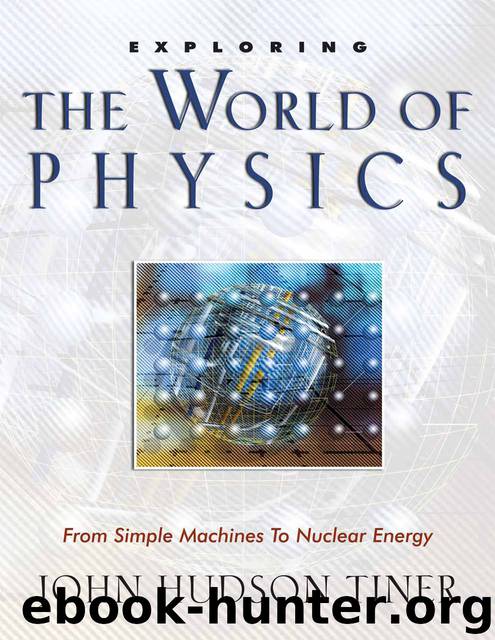Exploring the World of Physics by Tiner John Hudson

Author:Tiner, John Hudson [Tiner, John Hudson]
Language: eng
Format: epub
Tags: Science, SCIENCE / Physics, RELIGION / Religion &
ISBN: 9781614581567
Publisher: Master Books
Published: 2006-04-01T00:00:00+00:00
A slinky helps us understand the appearance of sound waves by the way it moves.
As people grow older, or if they have been exposed to loud noise over a long time, they lose the ability to hear sounds at each end of the frequency range. Even if you turn up the volume (make the sound louder), they cannot hear very low- or very high-pitched sounds.
The loudness of sound corresponds to the amplitude. The amplitude of a wave is a measure of its maximum displacement from its position of rest. A loud sound causes a greater displacement of the air molecules. They vibrate back and forth over a greater distance around their position at rest.
For a water wave, the amplitude is the distance from the axis to the crest or from the axis to the trough. Toss a pebble gently into water and watch waves. Then vigorously throw a heavy stone into the pond. In the second case, the waves will be bigger. They have greater amplitude than the small ripples.
Changes in amplitude do not change the frequency or velocity of a wave. For instance, a heavy boat that moves through water makes large waves that have large amplitude. A small boat barely moving through the water makes small ripples that have small amplitude. The waves from either boat move at the same speed across the surface of the water. In the same substance, waves travel at the same speed regardless of how they are made or their amplitudes.
Whether you yell or whisper, sound waves travel at the same speed. In air, a loud sound travels at the same speed as a soft sound. The loud sound will travel farther, but it travels no faster than the soft sound.
The frequency at which an object vibrates depends on its length, mass, and tension. You can illustrate some of the ways to change frequency by holding one end of a plastic ruler firmly against the side of a table and flip the end that extends beyond the table. The longer it extends over the edge of the table, the slower it vibrates because of the greater length. If you tape a coin to the free end, the ruler will vibrate at a slower rate because of the increased mass. Tension is important, too. If you replace the plastic ruler with a steel one that has a different tension, the pitch will change.
Stringed instruments also illustrate that length, mass, and tension change the frequency. Look at the strings on a bass, a guitar, and a mandolin. Notice the differences in length, thickness (mass), and tension. They produce different notes because of those differences.
Whenever the entire length of an object vibrates, it produces its natural or fundamental frequency. This is the lowest pitch it can produce. When a string is plucked in the middle, the string vibrates as a whole. It makes its lowest, or fundamental frequency.
At each end where the string cannot vibrate is a node. If you hold a string down in the middle, it has three nodes — one at each end and one in the middle.
Download
This site does not store any files on its server. We only index and link to content provided by other sites. Please contact the content providers to delete copyright contents if any and email us, we'll remove relevant links or contents immediately.
The Complete Stick Figure Physics Tutorials by Allen Sarah(7264)
Secrets of Antigravity Propulsion: Tesla, UFOs, and Classified Aerospace Technology by Ph.D. Paul A. Laviolette(5236)
Thing Explainer by Randall Munroe(3848)
The River of Consciousness by Oliver Sacks(3497)
The Order of Time by Carlo Rovelli(3096)
How To by Randall Munroe(2969)
A Brief History of Time by Stephen Hawking(2910)
I Live in the Future & Here's How It Works by Nick Bilton(2899)
The Great Unknown by Marcus du Sautoy(2612)
What If?: Serious Scientific Answers to Absurd Hypothetical Questions by Randall Munroe(2586)
Midnight in Chernobyl by Adam Higginbotham(2431)
Blockchain: Ultimate Step By Step Guide To Understanding Blockchain Technology, Bitcoin Creation, and the future of Money (Novice to Expert) by Keizer Söze(2408)
Networks: An Introduction by Newman Mark(2303)
The Meaning of it All by Richard Feynman(2268)
Easy Electronics by Charles Platt(2250)
The Tao of Physics by Fritjof Capra(2203)
Midnight in Chernobyl: The Untold Story of the World's Greatest Nuclear Disaster by Adam Higginbotham(2126)
When by Daniel H Pink(2056)
Introducing Relativity by Bruce Bassett(2046)
